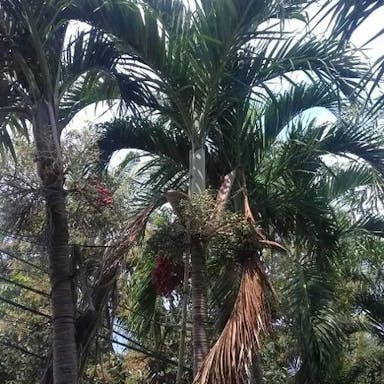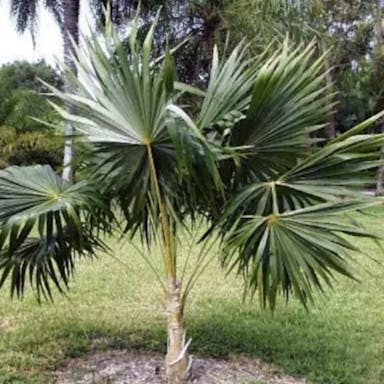Thatch palm, scientifically known as Sabal yapa, is a plant species from the Caribbean region, specifically the Dominican Republic and Haiti. The trunk can reach 20 meters and is covered in fibrous thatch. The leaves are fan-shaped, glossy, and dark green, up to 2 meters long. It has small white flowers in clusters and round black fruits. This palm grows in various conditions like drought, salt spray, and wind. It represents resilience due to its hardiness. The thatch covering makes it visually unique for landscapes.
Thatch palm
- Scientific name
- Sabal yapa
Basic Information
- Arecaceae Family Sabal Genus Thatch palm Species
- Arecaceae > Sabal > Sabal yapa
- 83%
- The Completeness of This Encyclopedia
Please help us complete the encyclopedia, Terrarium is a encyclopedia service to be completed with everyone in the world. Currently, this page is 83% complete. For more information on how to contribute, please click here.
- Palmae
- Tree
- Height
- 100000cm ~
- Flower Color
- Leaf Color
- Anthesis
- Sunlight Exposure
Full Sun Long hours of sunlight from morning to afternoon Partial Shade A location in the shade of a tree or where either the morning or afternoon is shaded Full Shade A place where there is no direct sunlight
- Full Sun
- Hardiness Zones
This is an indicator to know to which zone each plant can winter. Knowing the zone of each plant gives you an idea of the cold temperature resistance when grown in the ground without a roof. 2: -42.7 to -40.0 3: -39.9 to -34.4 4: -34.3 to -28.9 5: -28.8 to -23.3 6: -23.2 to -17.8 7: -17.7 to -12.2 8: -12.1 to -6.7 9: -6.6 to -1.1 10: -1.0 to 4.4 11: 4.5 to 10.0
- 10
- Cold resistance
- Poor
- Heat resistance
- Excellent
- Habitat of origin
- Mexico, Belize, Guatemala
- Growth Rate
- Slow
What is Thatch palm (Sabal yapa)?
What is Thatch palm (Sabal yapa)
Flower meaning
The Thatch palm, also known as Thrinax radiata, lacks a common flower language in America. Flower languages differ by culture and history. The Thatch palm has no widely used symbolic meanings in American flower language. But flower language isn't universal or standardized. It varies between regions and people. So consider the context and recipient when assigning symbolic flower meanings.
Calendar of Thatch palm (Sabal yapa)
Calendar
Thatch palm, known as Thrinax radiata, native to country. Blooms spring, summer. Flowers April to July, small, white. Blooming two, three weeks. Sunlight, water, nutrients help blooming. Pruning dead flowers, temperature help blooming longer. More details, refer botany resources, consult professional.
How to grow Thatch palm (Sabal yapa)
Watering
Thatch palm, scientifically known as Thrinax radiata, requires regular watering to thrive. It is important to water deeply and infrequently, allowing the soil to dry between waterings. During hot, dry periods provide a thorough soak every 7-10 days. In winter, scale back to watering every 2-3 weeks. Always check soil moisture before watering. Well-draining soil and adequate drainage prevents soggy conditions. Adjust watering frequency based on factors like temperature, humidity, soil type, and season. Root rot can occur if soil stays too wet. Deep watering promotes healthy roots. When growing palms, proper watering is crucial. Their needs change throughout the seasons. Pay close attention to soil moisture and environmental conditions to determine optimal watering regime.
Soil and Fertilizer
Thatch palm, scientifically known as Thrinax radiata, thrives in well-drained soil with a slightly acidic to neutral pH level ranging from 6.0 to 7.0. The fertilizer should be evenly spread around the base of the plant, avoiding direct contact with the trunk. Regular soil testing is essential to monitor the nutrient levels and pH of the soil. Specific fertilizers can be applied accordingly. It is important to follow the instructions provided by the manufacturer and avoid over-fertilization, as it can cause nutrient imbalances and harm the plant.
Sunlight and Place
Thatch palm, scientifically known as Thrinax radiata, is a plant that thrives in full sun exposure. This plant requires adequate watering during hot summers to avoid dehydration. It is highly tolerant to both cold and heat across a wide range of climates. Direct sunlight for over 6 hours daily is ideal. Thatch palm should be sited where it receives plentiful sunshine as it is known for withstanding intense light. Specific hourly sunlight requirements are unnecessary. Cold hardy down to 25°F (-4°C), some frost protection may be advisable. Optimal temperatures range from 65-85°F (18-29°C). With tolerance of heat and cold, it grows well in diverse temperatures.
Advanced Information of Thatch palm (Sabal yapa)
Pruning
Thatch palm, scientifically known as Thrinax radiata, requires regular pruning and cutting back to maintain its health and appearance. It is important to remove dead or damaged leaves, promote new growth, and prevent disease spreading. Pruning also helps shape the plant and stop overcrowding. The best season to prune Thatch palm is late winter or early spring, before the growing time begins. To prune Thatch palm, start by taking away any dead or yellowing leaves at the base of the plant. Use clean, sharp scissors to make tidy cuts at the base of the leaf stem. Be careful not to cut too close to the trunk, as this can harm the plant. It is important to wear safety gloves and glasses while pruning to avoid injury from the sharp leaves. After pruning, it is advised to give a slow-release palm fertilizer to provide key nutrients to the plant. Pour water on the palm thoroughly after pruning to help it get better and promote new growth. Regularly check the plant for any signs of insects or diseases and take proper actions to control them. Remember to get rid of the pruned leaves properly to prevent disease spreading. Pruning Thatch palm regularly will help maintain its overall health and look, ensuring a beautiful and growing plant.
Planting and Harvest
Thatch palm, scientifically known as Thrinax radiata, is a popular plant for both potted and in-ground planting. After two to three years or when the foliage has enlarged past its present container, repot the Thatch palm. Follow a similar process as planting initially, but opt for a slightly larger pot to allow for development. Improper upkeep can initiate the deterioration of the Thatch palm. It is vital to avoid excess water, as this may provoke decay of the roots. Enable the top section of earth to dry before additional hydration. Furthermore, administer balanced, slow-release plant food consistently to further strong progress. Keep pruning restricted to taking out lifeless or impaired leaves. For added precise data regarding the Thatch palm, direct towards respectable resources like the Royal Horticultural Organization or the College of Florida IFAS Extension.
Propagation
Thatch palm, scientifically known as Thrinax radiata, can be propagated through various methods. To propagate through seeds, collect ripe fruits and remove the pulp. Plant the seeds in a well-draining potting mix. Keep the soil moist and provide filtered sunlight. Waiting time may take over fourteen days. For division, carefully separate the offshoots from the parent plant, ensuring each division has roots attached. Put the divisions in separate containers with well-draining soil. Add water regularly and furnish indirect sunlight. To propagate through cuttings, take stem cuttings from the parent plant, ensuring they contain at least two nodes. Dip the cut end in rooting hormone and plant it in a well-draining potting mix. Keep the soil moist and make available indirect sunlight. Waiting time may take over fourteen days. Leaf cuttings can also be utilized for propagation. Take healthy leaves and cut them into sections, ensuring each section has a portion of the midrib. Plant the leaf sections in a well-draining potting mix, keeping the soil moist and providing filtered sunlight. New plants will form from the base of the leaf sections. Harvesting is not necessary for propagation methods mentioned above.
Pests and Diseases
Thatch palm, scientifically known as Thrinax radiata, is susceptible to several pests and diseases. For the prevention of infestation, regular inspection of the plant is necessary. Another pest that can affect this palm is the red mite. To prevent infestation, maintaining proper hygiene in the garden and regularly cleaning the leaves of the plant can be helpful. This palm is also susceptible to fungal diseases such as leaf spot and bud rot. To prevent these diseases, it is important to avoid overwatering the plant and to provide good air circulation around the leaves. In summary, this palm is susceptible to pests as well as fungal diseases. Regular inspection, proper hygiene, and appropriate preventive measures can help protect the plant from these issues. One common pest is the palm leaf skeletonizer, which is a type of moth larvae. These pests feed on the leaves, causing them to turn brown and wither. If any signs are found, appropriate measures should be applied. The red mites feed on the sap, causing the leaves to become discolored and eventually die. Maintaining hygiene and cleaning can prevent this. Leaf spot causes small, dark spots on leaves, leading to leaf death. Bud rot affects the growing point, causing decay. Avoiding overwatering and allowing air circulation prevents these. In summary, susceptibilities exist to pests and fungal diseases. With regular inspection and care, the issues can be prevented.
Habitat of Thatch palm (Sabal yapa)
Habitat
Toxicity of Thatch palm (Sabal yapa)
Health Benefits
- edible
- Inedible
- Toxic
- No toxicity
NO DATA
Toxic for dogs and cats
NO DATA
Q&A of Thatch palm (Sabal yapa)
- Is there a recommended way to choose Thatch palm?
Thatch palm, scientifically known as Thrinax radiata, is a popular plant for landscaping due to its attractive appearance and ability to tolerate various growing conditions. When selecting seedlings, insure naive plants are picked for purchase with vivid green leaves. Seeds should be bought from reputable suppliers for quality and authenticity. Thatch palm seeds are typically small, round, and brown or black colored. It is recommended to validate the plant is Thrinax radiata before purchase and not confused with other palm species. Proper identification prevents buying the incorrect plant.
- What Are the Uses of Thatch Palm Berries?
Thatch palm berries, scientifically known as Sabal yapa, are primarily used as a food source for wildlife. The vibrant red berries are eaten by various types of birds and small furry animals. This contributes to the biodiversity in their home. The red Sabal yapa berries have also been traditionally used by native people groups for natural medicine reasons. Some think they can help reduce swelling and act as a diuretic, but there is limited scientific proof. Sometimes the ornamental berries are used in landscaping. Their bright color and round shape can make gardens and parks more visually interesting.
- Where to Find Thatch Palm Plants for Sale?
Thatch palm plants, scientifically known as Sabal yapa, can be found for sale in various online plant nurseries and local garden centers. Additionally local centers may have this species available. It is a good idea to call ahead and check availability in your area. The Thatch palm thrives in warm climates. It can often be found in stores in such regions.








